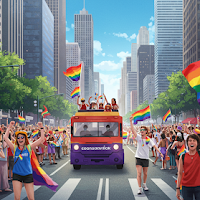Pride parades in major U.S. cities like New York and San Francisco have long been vibrant celebrations of LGBTQ+ identity, resilience, and community. Over the years, these events have grown from grassroots demonstrations into massive cultural festivals, drawing millions of participants and viewers worldwide. Yet, in recent times, the nature of Pride parades has evolved significantly, shaped by changing social expectations, corporate involvement, and political tensions.
From Grassroots to Global Stages
Pride began as a protest a defiant response to systemic discrimination, notably sparked by the Stonewall riots in 1969. Early Pride marches were acts of resistance and demands for equality. Fast forward to today, and Pride parades have become highly organized and large-scale events featuring floats, performances, and a notable presence from multinational corporations.
Cities like New York and San Francisco host some of the biggest Pride events, which draw diverse crowds including families, allies, activists, and tourists. These celebrations now blend festivity with advocacy, highlighting ongoing struggles for rights while also embracing inclusivity and joy.
The Rise of Corporate Sponsorship and DEI Initiatives
One of the most visible changes in Pride events is the increasing role of corporate sponsorships. Major companies across industries from tech giants to financial institutions now prominently sponsor Pride parades. This trend reflects the growing emphasis on Diversity, Equity, and Inclusion (DEI) initiatives within corporate America.
For many companies, sponsoring Pride is both a demonstration of support for LGBTQ+ rights and a strategic branding opportunity. The presence of corporate floats and booths signals an alignment with social justice values, aiming to attract LGBTQ+ customers and inclusive-minded employees.
DEI programs in these corporations often involve broader commitments: from adopting inclusive workplace policies to actively recruiting LGBTQ+ talent. Sponsoring Pride thus becomes an extension of these efforts, reinforcing corporate messages about equality and social responsibility.
The Complex Relationship Between Corporations and the LGBTQ+ Community
While corporate participation has brought more visibility and resources to Pride events, it has also sparked debates within the LGBTQ+ community. Critics argue that some companies engage in “rainbow-washing” leveraging Pride for marketing without meaningful action to support LGBTQ+ rights year-round.
Some activists question whether the increasing corporate presence dilutes the protest roots of Pride, turning it into a commercial spectacle that sidelines grassroots voices and urgent advocacy. Additionally, corporations must navigate the delicate balance of engaging with political controversies without alienating segments of their consumer base.
Despite these tensions, many companies are genuinely investing in LGBTQ+ causes through philanthropic initiatives and employee resource groups. The dialogue continues, reflecting the ongoing negotiation between activism and corporate interests in shaping modern Pride.
Political Backdrop: Trump Era and Beyond
Pride parades have also been affected by the broader political climate. The Trump administration’s policies and rhetoric on LGBTQ+ issues led to heightened activism and, in some cases, resistance from conservative groups.
In cities like New York and San Francisco, Pride organizers have worked hard to maintain inclusive spaces that celebrate diversity while also responding to external political pressures. The participation of corporations and public figures often serves as a counterbalance to political hostility, reinforcing the message of acceptance and equality.
The Future of Pride: Balancing Celebration, Activism, and Corporate Influence
As Pride parades continue to evolve, organizers, participants, and sponsors face the challenge of preserving the spirit of protest and advocacy amid growing commercialization. Many events now incorporate educational programming, support for LGBTQ+ nonprofits, and calls to action alongside entertainment.
Looking ahead, the intersection of social movements, corporate responsibility, and political realities will shape how Pride is experienced and understood. The hope remains that Pride will stay true to its roots as a powerful symbol of LGBTQ+ resilience while adapting to contemporary dynamics.


